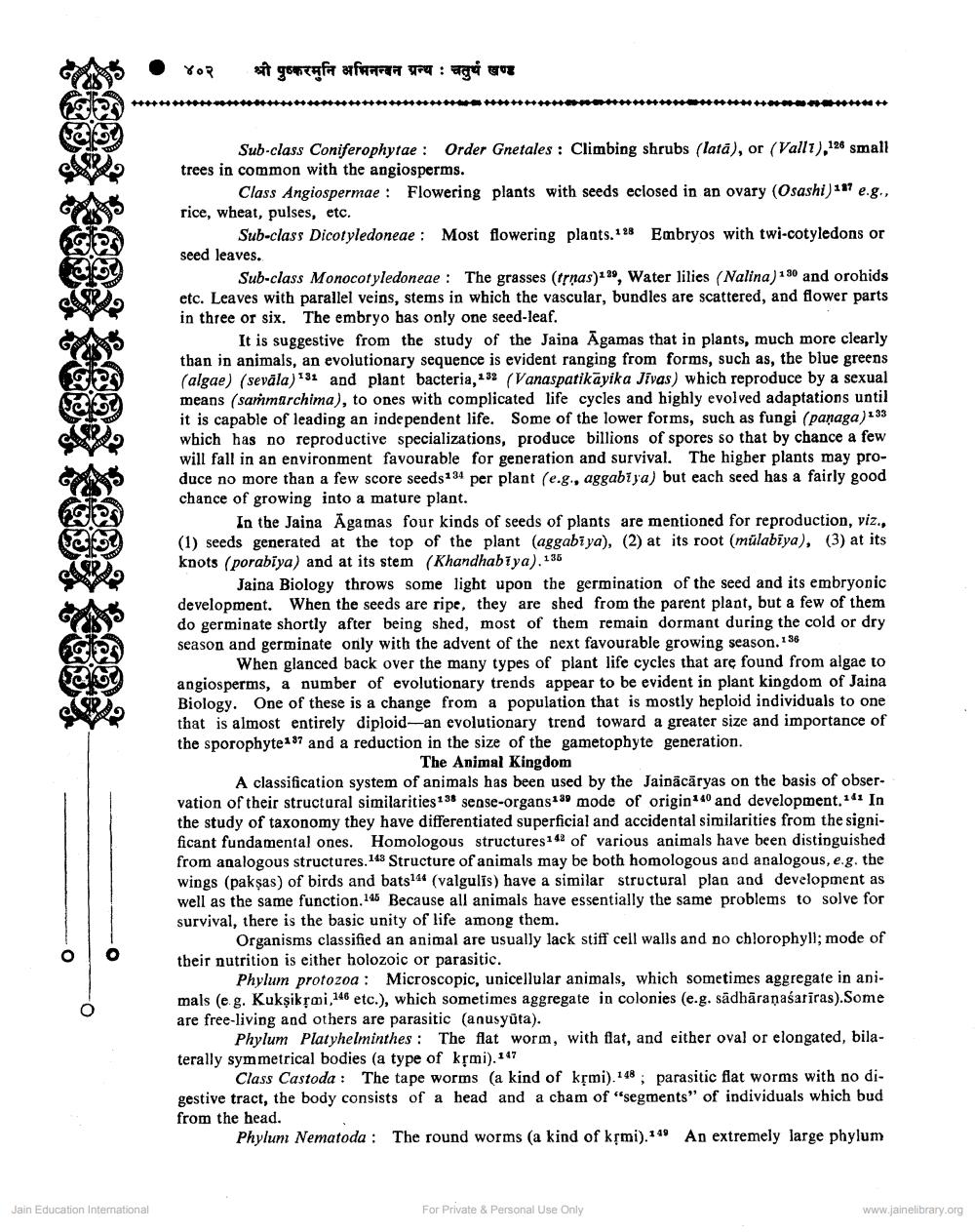________________
४०२
श्री पुष्करमुनि अभिनन्दन ग्रन्थ : चतुर्थ खण
Sub-class Coniferophytae : Order Gnetales : Climbing shrubs (lata), or (Valli),126 small trees in common with the angiosperms.
Class Angiospermae : Flowering plants with seeds eclosed in an ovary (Osashi) 117 e.g., rice, wheat, pulses, etc.
Sub-class Dicotyledoneae : Most flowering plants.1 28 Embryos with twi-cotyledons or seed leaves.
Sub-class Monocotyledoneae : The grasses (trnas): 29, Water lilies (Nalina) 130 and orohids etc. Leaves with parallel veins, stems in which the vascular, bundles are scattered, and flower parts in three or six. The embryo has only one seed-leaf.
It is suggestive from the study of the Jaina Āgamas that in plants, much more clearly than in animals, an evolutionary sequence is evident ranging from forms, such as, the blue greens (algae) (sevāla) 132 and plant bacteria, 132 (Vanaspatikāyika Jivas) which reproduce by a sexual means saṁmarchima), to ones with complicated life cycles and highly evolved adaptations until it is capable of leading an independent life. Some of the lower forms, such as fungi (panaga) 133 which has no reproductive specializations, produce billions of spores so that by chance a few will fall in an environment favourable for generation and survival. The higher plants may produce no more than a few score seeds 134 per plant (e.g., aggabiya) but each seed has a fairly good chance of growing into a mature plant.
In the Jaina Āgamas four kinds of seeds of plants are mentioned for reproduction, viz., (1) seeds generated at the top of the plant (aggabi ya), (2) at its root (mülabiya), (3) at its knots (porabiya) and at its stem (Khandhabiya). 135
Jaina Biology throws some light upon the germination of the seed and its embryonic development. When the seeds are ripe, they are shed from the parent plant, but a few of them do germinate shortly after being shed, most of them remain dormant during the cold or dry season and germinate only with the advent of the next favourable growing season. 136
When glanced back over the many types of plant life cycles that are found from algae to angiosperms, a number of evolutionary trends appear to be evident in plant kingdom of Jaina Biology. One of these is a change from a population that is mostly heploid individuals to one that is almost entirely diploid-an evolutionary trend toward a greater size and importance of the sporophyte 137 and a reduction in the size of the gametophyte generation.
The Animal Kingdom A classification system of animals has been used by the Jainācāryas on the basis of observation of their structural similarities 138 sense-organs 138 mode of origin 140 and development. 14: In the study of taxonomy they have differentiated superficial and accidental similarities from the significant fundamental ones. Homologous structures142 of various animals have been distinguished from analogous structures. 145 Structure of animals may be both homologous and analogous, e.g. the wings (paksas) of birds and bats144 (valgulis) have a similar structural plan and development as well as the same function.145 Because all animals have essentially the same problems to solve for survival, there is the basic unity of life among them.
Organisms classified an animal are usually lack stiff cell walls and no chlorophyll; mode of their nutrition is either holozoic or parasitic.
Phylum protozoa: Microscopic, unicellular animals, which sometimes aggregate in animals (e. g. Kuksikrmi, 146 etc.), which sometimes aggregate in colonies (e.g. sadhāranaśariras).Some are free-living and others are parasitic (anusyuta).
Phylum Platyhelminthes : The Alat worm, with flat, and either oval or elongated, bilaterally symmetrical bodies (a type of krmi). 147
Class Castoda : The tape worms (a kind of ksmi).148 ; parasitic flat worms with no digestive tract, the body consists of a head and a cham of "segments" of individuals which bud from the head.
Phylum Nematoda : The round worms (a kind of ksmi).148 An extremely large phylum
Jain Education International
For Private & Personal Use Only
www.jainelibrary.org




